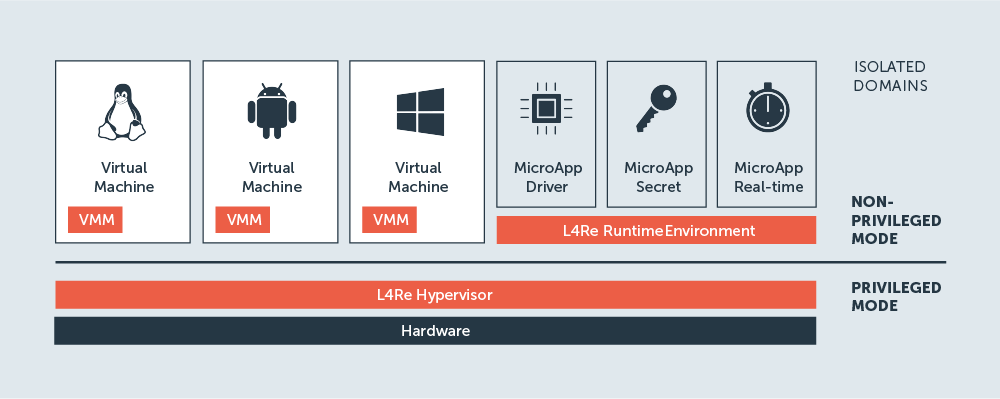Architecture Overview
The intention of this section is to provide a short overview about the L4Re
Operating System Framework. For a more in-depth introduction, see
Architecture Concepts
Architecturally, L4Re is a microkernel -based operating system. That is,
the amount of code that is running in the most privileged level in the system
is kept reasonably small. This design is key to building a secure and reliable
system from ground up.
L4Re System Structure
The L4Re Operating System has a multi-tier architecture consisting of the
following layers:
L4Re’s system architecture
Microkernel
The L4Re Microkernel is the component at the lowest level of the software
stack. It is the only piece of software of the L4Re operating system that
runs in a higher privilege level of the processor to be able to program
to processor’s isolation features.
The kernel provides primitives to execute programs in tasks, to enforce
isolation among them, and to provide means of secure communication in order
to let them cooperate. As the kernel is the most privileged,
security-critical software component in the system, it is a general design
goal to make it as small as possible in order to reduce its attack surface.
It provides only a minimal set of mechanisms that are necessary to support
applications.
Runtime Environment
The small kernel offers a concise set of interfaces, but these are not
necessarily suited for building applications directly on top of it. The L4Re
Runtime Environment aims at providing more convenient abstractions for
application development. It comprises low-level software components that
interface directly with the microkernel. The root pager sigma0 and the root
task Moe are the most basic components of the L4Re Runtime Environment.
Other services (e.g., for device enumeration) use interfaces provided by
them.
Applications
Applications run on top of the system and use services provided by the
runtime environment – or by other applications. There may be several types
of applications in the system and even virtual machine monitors and device
drivers are considered applications in L4Re. They are running alongside
other applications on the system.
Lending terminology from the distributed systems area, applications offering
services to other applications are usually called servers , whereas
applications using those services are named clients . Being in both roles
is also common, for instance, a file system server may be viewed as a server
with respect to clients using the file system, while the server itself may
also act as a client of a hard disk driver.
Virtual Machines
Virtual machines (VMs) provide a virtual environment to run a whole
operating system with its applications. VMs are run by a hypervisor,
similar that applications are run by an operating system.
L4Re is both an operating system and a hypervisor, i.e., it can run
L4Re applications side-by-side with VMs. In L4Re, a virtual machine
monitor program (VMM) provides the virtual environment for a guest
operationg system.
Device virtualization is primarily implemented through Virtio, the
defacto standard for virtual devices and commonly available in many
operating systems already.

